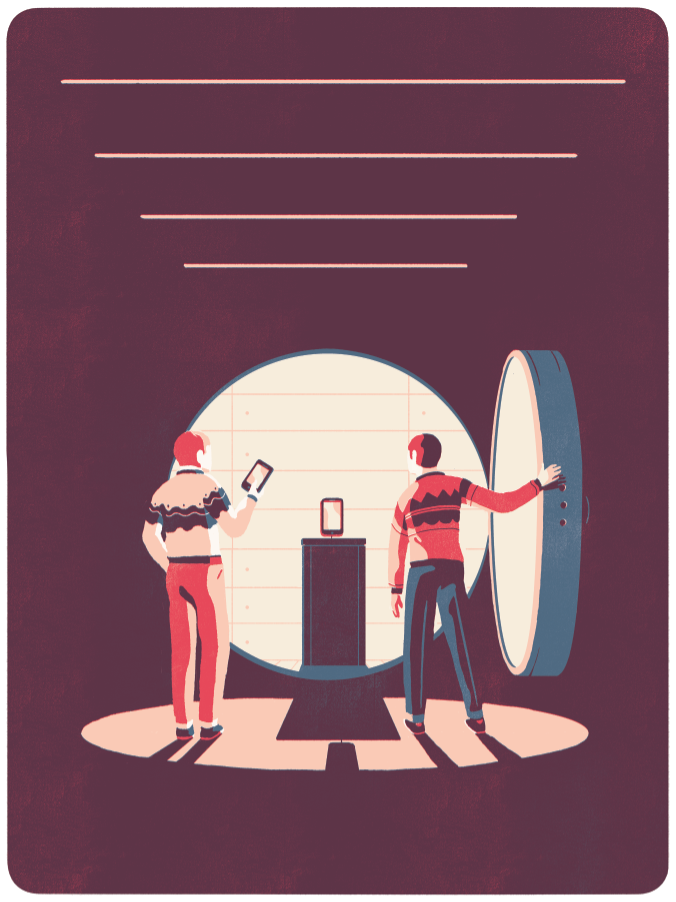Social Currency
Peer to peer payments are allowing money to flow between friends digitally

It seems money is undergoing a bit of a makeover at the moment with social networking features making their way into our bank accounts. What does this mean for our wallets?
The December 2014 marketing video for Apple Pay, an iPhone 6 tool that lets users pay at retail stores using their smartphones rather than cards or cash, featured a familiar narrative. A woman tries to pay for her coffee, but digs around in her bag for her wallet. The digging continues for a painfully long time before she finally comes up with the requisite currency. But! With Apple Pay, she has only to tap her phone to a cash-register terminal, and walk away with her latte. Such is the promise of mobile payments, the catch-all term for platforms that transfer money using portable technology.
The thinking goes that cash and credit cards are old technologies, ripe for disruption. They’re slow, inflexible and resolutely physical. But the problem with mobile wallets like Apple Pay, which try to make your bank account digital, is that they’re just not catching on as some thought they would. Gartner predicts that, by 2017, mobile payments worldwide will reach $721bn, but NFC systems like Apple Pay will make up only 5% of the total value.
The real success stories of digital money are apps that combine mobile payments with social network aspects in peer-to-peer systems. Apps like Venmo (a subsidiary of the digital money giant PayPal), EU start-up Payfriendz and Snapchat’s Snapcash (a partnership between Snapchat and the payments processor Square) allow money to flow between friends digitally.
The volume of such peer-to-peer payments is expected to reach 56.7m in the UK in 2015, with the highest users being millennials. In the US, the value of such transactions will rise to $7bn, according to Javelin Strategy & Research. Venmo has become the star of the current crop of peer-to-peer payment apps, not just for its convenience but because it turns money into an opportunity for communication.
Every Venmo payment, whether to a friend for a beer or to a roommate for rent, must be accompanied by a brief blurb about the purpose of the exchange, which can be seen by friends on the app, as long as the payment is set to “public”. Often, these notes take the form of emoji, which have to be interpreted, koan-like, by readers.
“It becomes part of the game,” says Chiara Atik, a young New York City playwright who wrote a popular essay for <Matter> about watching a couple break up via Venmo exchanges. It's so fantastically easy to transfer money without having to get people's bank information or cash from an ATM.
“The mandatory notes that show up in the public feed become performative, fun, or enlightening, depending on who's doing it,” she says. “Going out to dinner in a group has never been easier. But I think the social aspect makes it fun, too.” Fun is not a word usually associated with cash, but Venmo has managed to challenge this connotation.
It’s this social quality, the ability to add messages, multimedia and group functionality to payments meant for real-life friends instead of just Facebook ones, that makes these peer-to-peer apps so appealing. It’s no wonder then that Venmo’s growth statistics point toward a strong future. The company processed $700m in the third quarter of 2014, a 50% expansion over the previous quarter.
Venmo is benefitting from a “first-mover advantage,” says Tony Gallippi, the co-founder of BitPay, a digital financial services company. Venmo has “the mindshare”, helped along, no doubt, by the scale of its parent company, which in turn is owned by eBay.
“Convenience plays a huge role in Venmo’s popularity,” Atik explains. Similarly, Snapcash and Payfriendz skip several steps often needed to move money, shortcutting interactions that might be awkward – what businesses often call “pain points”. “It's so fantastically easy to transfer money without having to get people's bank information or cash from an ATM,” says Atik.
It's fun to see what people are sending people money for! The voyeuristic aspect of Venmo is part of its appeal. Avoiding pain points between friends and businesses is also the purpose of Cover. It lets any number of customers pay for dinner through their phone without needing to wait for the bill or laboriously gathering each diner’s cash or card contribution.
“The experience is as frictionless as possible, allowing people to focus on what matters, which is hanging out with your friends,” says co-founder Andrew Cove. In the case of Cover, processing mobile payments helps smooth a night out. “You’ve removed a transaction from your social experience,” Cove says. “It’s a surprisingly freeing thing.”
While Venmo and Cover exist as independent platforms, Snapcash piggybacks off existing social networks to gain users. The millennials targeted by such companies are already active members on these platforms, so the added functionality of money transfer makes sense.
For some people, however, peer-to-peer payment isn’t enough of a draw. “Users often think ‘if I can’t use it at my grocery store it has no value’,” Gallippi says. While it’s true that Venmo is thriving in a limited-use case – exchanging money between friends – it’s unlikely to be a mainstream substitute for cash if it can’t be used in other, more mundane situations like, for instance, going to a market.” There are entrance requirements for these apps, as identity information needs to be added and the relevant company needs access to your bank account.
Competition is strong, since businesses dealing directly with money have an easier path to profitability than those monetising through ads or data sales. M-Pesa has made enormous inroads in financially underserved countries such as Kenya and Afghanistan, where texting money back and forth is far easier than going to the bank.
In more developed countries, this is a harder sell, because cash, for all its flaws, still works pretty well for paying for coffee. Instead, mobile payments apps like Venmo should focus on what makes them unique: their human aspect. “It's fun to see what people are sending people money for! Sushi? Cable bill? Heart emoji?” says Atik. “The voyeuristic aspect of Venmo is part of its appeal.”
By promoting these social connections, apps like Venmo bring us into a closer relationship with our money. Through the feed of messages, we see how money flows between people and businesses, what people pay for and why. It’s the kind of transparency that the internet is great at creating and that has been missing from monetary transactions for a long time. The popularity of these apps isn’t just about making spending money easier, but about understanding it better.


